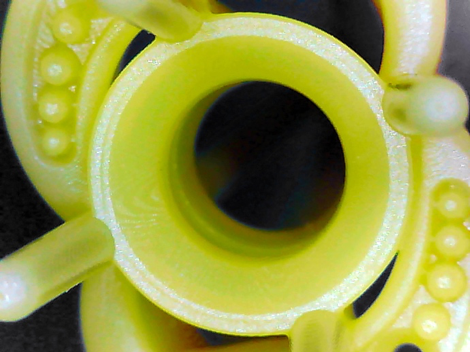What factors affect final casting results? Should you have to choose between speed and quality?
Over the past few years, 3D printing has been transforming the jewelry industry. The introduction of 3D printers gives jewelers the capability to produce castable, high detailed parts in a fraction of time. But not all 3D printers are created equal, and casting results may vary widely, leaving some custom jewelers and manufacturers frustrated.
3D printing cuts production time dramatically when compared to traditional hand-carving methods; however, lately there has been a race for developing faster 3D printers for jewelry making with the goal to produce rings in a matter of minutes and not hours. But does build speed really matter in 3D printing? Should you have to sacrifice quality to achieve it?
“If you are serious about your work and you are passionate about what you do then, it’s going to pay off to invest in a professional machine”. -Isaac Cohen | Isaac’s Fine Jewelry
With a long-standing history of additive manufacturing innovation and a dedication to the jewelry industry for over 15 years, EnvisionTEC focuses on real solutions to real application problems. EnvisionTEC introduced its patented Continuous Digital Light Manufacturing (cDLM) technology so that jewelry professionals wouldn’t have to choose because cDLM allows for the building of jewelry patterns in wax material using a method that addresses both speed AND quality.
DLP technology, which was first developed and patented by EnvisionTEC, has long been the gold standard for 3D printing jewelry. A standard DLP 3D printer builds parts in layers, one layer at a time. Each layer must be exposed to the light source and the time of exposure is defined by layer thickness and material reactivity. Once a layer has been exposed, and the specified layer is formed, a layer separation procedure is performed to peel the layer from the bottom of the material tray and replenish fresh resin to cure the next layer.
Over the years, EnvisionTEC has perfected a number of patented methods of minimizing the effects of this peeling separation, with highly castable options available to the jewelry industry that are widely used from custom designers to large manufacturers. But there are limits to the amount of wax that can be used with DLP 3D printing.
When using wax-based materials, the exposure times are typically three to four times that of regular plastic acrylic polymers. The higher the material castability (i.e. wax content), the slower the exposure time. A number of other manufacturers of 3D printers claim that they can produce rings in minutes using a standard layer peeling process; however, their resins contain much more plastic than wax, resulting in less than optimal casts with significant surface roughness and porosity.
EnvisionTEC’s cDLM technology works by adding an air gap (similar to the air gap below the puck on an air hockey table surface) between the part being built and the bottom of the material tray. By building a floating layer, the separation forces are completely eliminated – so there is no peeling at all. With no separation forces, cDLM 3D printers are able to print resins with up to a 90% wax fill (Easy Cast 2.0), allowing for patterns that are as easy to cast as any traditional hand-carved or injection molded wax pattern.

The lack of separation forces provide several key benefits to jewelers. The first, of course, is that it allows the use of very soft materials, such as the highly wax-filled, that would normally stretch and delaminate during a peeling process. Beyond that, those same materials can be 3D printed using minimal support structures. Normally, supports are added to help combat the separation forces from pulling a pattern apart during a build, especially fine-detailed, intricate pieces. cDLM technology allows for extremely delicate pieces to be built AND casted successfully. Fewer supports also greatly affects hands-on finishing time with beautifully smooth results in a fraction of the time.

On top of all of this, the cDLM process is fast, allowing jewelers unprecedented manufacturing turnaround times. When EnvisionTEC released the first cDLM 3D printer, the Micro Plus cDLM, the company presented a real game changer to the jewelry industry. Traditionally, 3D printing castable materials would take hours to build. However with the cDLM technology, bridal and fashion rings can be designed, grown, and ready for investment casting the same day, which is a huge advantage for the jewelry market.
EnvisionTEC has now grown their cDLM product family to include four models ideal for jewelry pattern production for casting. EnvisionTEC’s cDLM 3D printers can build highly detailed patterns for direct investment casting in a matter of minutes rather than hours without sacrificing the high quality that jewelers expect to offer their clientele.
If you need a solution for 3D printing premium quality wax patterns for jewelry quickly that can also be casted easily, look no further than EnvisionTEC’s cDLM technology. For more information visit: www.envisiontec.ciwebstudio.com/castables
IT’S SUPER-FAST — CONTINUOUS DIGITAL LIGHT MANUFACTURING 3D PRINTING TECHNOLOGY
- A layerless part with no stair stepping caused by starting and stopping build platform.
- Parts built as the platform moves continuously without separation, which leads to a drastic reduction in the building time as well as allowing for highly wax-filled resins to be used.
- A drastic reduction in separation forces delivers highly accurate parts, with detailed feature resolution.
- Fewer supports are required, thereby delivering a near scar free pattern, with minimal or no time required for support removal and almost zero finishing time.
- Better castability, as the wax-based resin is cured twice as much during the build process, when compared to building using non continuous traditional DLP 3D printers. This delivers a porosity-free casting from EnvisionTEC’s ash free castable materials.




